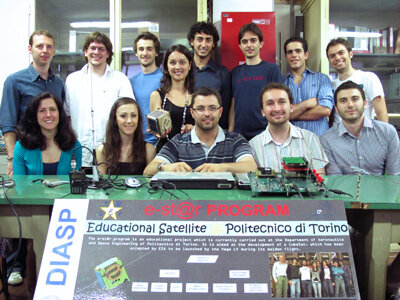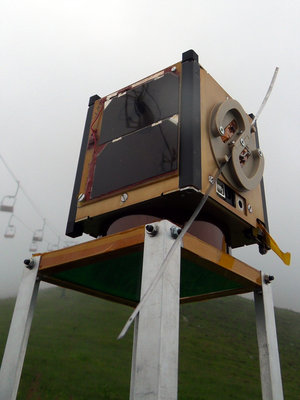Meet the teams: e-st@r
Seven teams of university students were selected to fly their CubeSats on the maiden flight of ESA's Vega launch vehicle. Here is an introduction to e-st@r, one of the Italian teams on the flight.
| University | Politecnico di Torino, Italy |
| Endorsing professors | Sergio Chiesa, Sabrina Corpino, Nicole Viola |
| Team | Fabrizio Stesina, Guido Ridolfi, Alessandro Rougier, Valerio De Iacovo, Gerard ObiolsRabasa, Fabio Nichele, Gilbert Fanchini, Davide Falsetti, Federica Pellegrini,Lorenzo Feruglio, Alessio Piumatti, Alberto Bruno, Davide Gagliostro, Roberto Secchi, Matteo Cesaretti, Alessandro Mannarelli, among others |

The e-st@r programme has been developed by undergraduate and graduate students in the Politecnico di Torino, with some PhD students participating as consultants on specific subjects. Some work was undertaken during regular courses, as part of the students' class work.
The team was divided into several groups, each led by a student, under the supervision of Professor Sabrina Corpino, who acted as project manager. A system engineering team was also established, with the aim of overseeing the project at system level. The AeroSpace System Engineering Team (ASSET), led by Professor Sergio Chiesa, coordinated the students’ activities.
The main objective of e-st@r is to educate space-engineering students in complex system design and management, team work and implementation of official standards. At the same time the programme is intended to provide insights into the development of new technologies for low-cost access to space. e-st@r also has several scientific objectives, which reflect the interests of the scientific and industrial communities.
The satellite carries the Active Attitude Determination and Control System (A-ADCS) technology experiment, which is designed to demonstrate the feasibility of active control of a CubeSat's attitude by magnetic actuation.
The introduction of attitude control is one of the most important means of improving the capabilities of future CubeSats, and small satellites in general. Giving a CubeSat the ability to actively control its attitude may represent a key point for future development of complex missions involving small satellites. The factors influencing the choice of this experiment included: the importance of the outcomes of the experiment; the impact of the experiment on e-st@r's mission success and reliability; the knowledge and background of the team; the available resources for the development of the experiment in terms of budget, facilities and people; and the period of time available for development.
The team expects to receive a stream of telemetry containing various parameters related to the attitude of the satellite. The data will be analysed and used to further update the onboard ADCS software, if needed. The data will also be useful for improving future ADCS models used for simulation.
The CubeSat experience

What did the team members think about their experience of CubeSat selection, design, construction, testing and integration?
"Participating in the e-st@r project has been really important because we experienced a real space programme. The hands-on practice approach helps students to test what they have studied in books. Working in a team and sharing our experience with students from other countries is another important aspect for our future careers."
Read more about e-st@r on their website.






